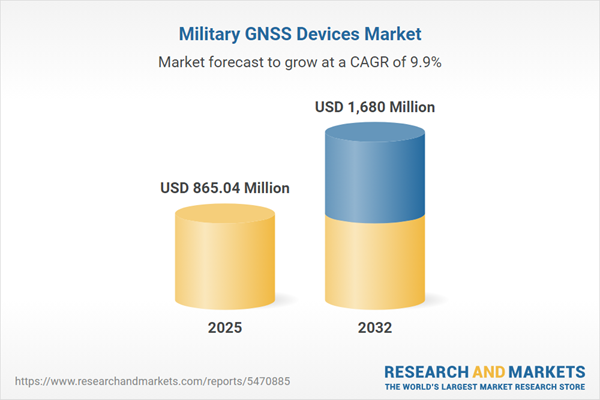Speak directly to the analyst to clarify any post sales queries you may have.
Defense organizations are steadily enhancing military GNSS device integration to bolster secure navigation and resilient communications in complex, contested environments. The military GNSS devices market is experiencing sustained momentum as secure global positioning and data assurance remain central to operational readiness.
Market Snapshot: Military GNSS Devices Market Size and Growth
The global military GNSS devices market is valued at USD 792.67 million in 2024, with projections rising to USD 865.04 million in 2025 and surpassing USD 1.68 billion by 2032. The market is supported by a robust compound annual growth rate of 9.85%, reflecting continuous defense modernization and dedicated investments in advanced navigation technologies. Land, air, and maritime forces are prioritizing secure and interoperable platforms, aiming to deliver strong operational reliability and enable effective collaboration for joint and coalition missions.
Scope & Segmentation of the Military GNSS Devices Market
This analysis equips defense stakeholders with actionable insights on adoption drivers, technology readiness, and evolving procurement landscapes. The segmentation clarifies market dynamics and helps identify emerging opportunities in the military GNSS devices market across several vital categories:
- Product Types: Antennas maintain GNSS signal integrity and precise timing; data links ensure secure communications in operational environments; clock technologies synchronize operations; receivers provide reliable positioning under multi-threat scenarios; simulators facilitate realistic, scenario-based personnel training.
- Platforms: Includes manned and unmanned aerial vehicles, portable handheld devices for field units, maritime units deployed on naval vessels, and vehicle-mounted systems supporting mobile real-time navigation.
- Applications: Mapping tools empower situational awareness, navigation systems guide asset movement, and targeting solutions support operational precision and effectiveness.
- Geographical Regions: Coverage spans the Americas, Europe, Middle East, Africa, and Asia-Pacific, highlighting variations in regulatory environments, adoption pace, and policy impacts shaping GNSS implementation.
- Competitive Landscape: Major defense primes such as Lockheed Martin, BAE Systems, RTX Corporation, Northrop Grumman, and Thales are present, alongside technology innovators diversifying sector offerings and driving specialized advancements.
Key Takeaways for Senior Decision-Makers
- Rising electronic warfare threats underscore the necessity for anti-jamming and authentication capabilities to maintain information integrity and support uninterrupted missions.
- Adopting modular and upgradeable system designs enables rapid adaptation to evolving threats and changing operational contexts.
- Enhancing domestic supply chains with diversified sourcing strategies supports resilience against market and provider disruptions.
- Quantum-resistant encryption and artificial intelligence-powered data protection secure navigation information and facilitate trusted integration across military networks.
- Industry partnerships between established contractors and specialized technology firms improve platform interoperability essential for coalition and joint initiatives.
- Regional adoption strategies reflect operational needs: the Americas emphasize seamless system integration; EMEA targets scalability; Asia-Pacific tailors defenses through region-specific countermeasures.
Tariff Impact on Military GNSS Device Supply Chain
- Tariff fluctuations are increasing production and component costs, requiring a reevaluation of procurement models to align with evolving budget priorities while safeguarding capability.
- Sourcing diversification and building resilient supply networks are essential as international regulations and trade conditions continue to shift.
- Strengthening domestic and regional supplier bases mitigates exposure to global supply chain disruptions.
- Modular system frameworks enable organizations to rapidly adapt to regulatory adjustments and sustain mission readiness amid external changes.
Research Methodology & Data Sources
This report is built on thorough secondary research, benchmarking of industry standards, and detailed regulatory reviews. Insights are further validated through direct input from industry leaders, technical experts, and structured SWOT along with value chain analysis, ensuring an impartial view of current and upcoming market forces.
Why This Report Matters
- Enables defense executives to strategically align GNSS system investments with flexible operational and security requirements across diverse operational theatres.
- Delivers targeted regional analysis to support agile procurement, improve supply preparedness, and facilitate integration of emerging technologies within defense structures.
- Highlights innovation pathways and new partnership opportunities, helping organizations prepare for the adoption and seamless integration of future-ready military navigation solutions.
Conclusion
Advancements in military GNSS technology are defining the future of defense operations in digital battlefields. Effective strategies and adaptive procurement will remain critical for sustaining operational capability in dynamic threat environments.
Additional Product Information:
- Purchase of this report includes 1 year online access with quarterly updates.
- This report can be updated on request. Please contact our Customer Experience team using the Ask a Question widget on our website.
Table of Contents
3. Executive Summary
4. Market Overview
7. Cumulative Impact of Artificial Intelligence 2025
Companies Mentioned
The companies profiled in this Military GNSS Devices market report include:- Lockheed Martin Corporation
- BAE Systems plc
- RTX Corporation
- Northrop Grumman Corporation
- Thales Group
- Avidyne Corporation
- L3Harris Technologies, Inc.
- Trimble Navigation Ltd
- Seiko Epson Corporation
- Trimble Inc.
- Topcon Positioning Systems Inc.
- Septentrio N.V.
- Safran Group
- LOCOSYS Technology Inc.
- Leonardo DRS
- Juniper Systems Inc.
- JAVAD GNSS Inc.
- Honeywell Aerospace Technologies
- Hertz Systems Ltd Sp. z o.o.
- Gladiator Technologies
- General Dynamics Mission Systems, Inc.
- Elbit Systems Ltd.
- Accord Software & Systems Pvt Ltd.
- Hexagon AB
- V3 Novus
Table Information
| Report Attribute | Details |
|---|---|
| No. of Pages | 186 |
| Published | October 2025 |
| Forecast Period | 2025 - 2032 |
| Estimated Market Value ( USD | $ 865.04 Million |
| Forecasted Market Value ( USD | $ 1680 Million |
| Compound Annual Growth Rate | 9.8% |
| Regions Covered | Global |
| No. of Companies Mentioned | 26 |









